|
|
|
|
Community Holds Candlelight
"Visual" in Support of Officers
Dec 12, 2006 09:33 PM
News 4
(Buffalo, NY, December 12, 2006) - - The community
gathered in support of the wounded officers Tuesday night
at the scene of the shooting. News 4's Michele McClintick
has more on a special event they're calling a candlelight
"visual."
One week after the shooting on West Chippewa Street, a
community gathered at the very same place to show two
Buffalo police officers support and to pray for their
recoveries.
Officers Carl Andolina and Patricia Parete were shot while
working near the Chippewa district.
While Andolina recovers at home, Patricia Parete remains
hospitalized at ECMC.
21-year-old Steven Schroeder wants to make sure the two
officers know a community is supporting them.
Schroeder said, "Our main concern tonight is to show
the police that we support them, and we have their back,
and we love the job that they do."
Although he dosen't know the two officers personally, he's
worked in the Chippewa district long enough to know many B
District police officers, and appreciates the difficult
and often dangerous work they do each and every day.
Schroeder said, "We get to know them on a personal
level, more than just a professional level."
Tuesday night's "visual", as they're calling it,
allowed fellow officers and the community to light a
candle, say a prayer, and just show support to those who
wear the uniform and badge each and every day.
Schroeder said, "We will have index cards so that
people can write messages and prayers to the officers, and
we're going to make sure that their families get
them."
That uniquely named candlelight "visual" for
both officers was from 9:00 until 11:00 Tuesday night at
the scene of the shooting on West Chippewa between Elmwood
and Georgia. |
Chippewa Shooting Going to Grand Jury
Posted by: Mike Igoe, Reporter
Created: 12/12/2006 4:21:10 PM
Updated: 12/12/2006 6:18:02 PM
A Buffalo teenager accused of shooting
two Buffalo police officers was back in court Tuesday
afternoon.
Eighteen year old Varner Harris, who allegedly shot
officers Carl Andolina and Patricia Parete on the night of
December 5th, faced a felony hearing Tuesday.
Harris waived his right to the hearing so the case now
heads to a grand jury. Harris will remain in jail for up
to 45 days. During that time, the grand jury either has to
issue an indictment or a plea deal can be worked out.
The courtroom of Judge David Manz was packed and the
majority of the people were police officers.
Not only were the Buffalo police represented, but New York
State troopers were on hand as well as representatives
from a few other police departments.
Buffalo police Commissioner H. McCarthy Gipson was
impressed by the showing of support: "Today's effort
in showing of strength on the part of our law enforcement
shows that we at the beginning point of entering people
into the process are united and together."
Lieutenant Joe Panus of the Buffalo police was also
impressed by the turnout: Just a very good feeling. I
always knew that we stood behind each other and today just
proved it. We were there for our two officers."
Mike Igoe: "Were you surprised how many officers did
show up today?" Panus: "I wasn't surprised. But
it made me feel good to see it. I wasn't surprised-not at
all."
Another sign of support is scheduled for tonight. There
will be a candlelight vigil from 9-11pm at the corner of
Elmwood and Chippewa.
|
|
|
|
New Information on Wounded Officer's
Condition
Posted by: Robyn Young, WGRZ 2News Reporter
Posted by: Sally Durwald, WGRZ 2News Producer
Created: 12/8/2006 10:33:32 AM
Updated: 12/8/2006 10:58:37 AM
WGRZ 2News
Buffalo Police officer Patricia Parete remains in critical
condition at E.C.M.C as of Friday morning. Tuesday night she
was shot in the jaw while responding to a fight call on
Chippewa Street.
A close family friend who has spent a lot of time with
Parete in the intensive care unit tells Channel 2 News the
bullet is still in Parete's neck, and that doctors are not
yet able to say if she will be paralyzed, or even exactly
how much damage the bullet caused to the officer's spine.
Parete underwent an estimated 6 hour surgery Wednesday and
faces more surgery on her jaw.
Several sources say she is able to communicate by blinking
and moving her head and is responding to questions.
Her family issued this statement on Thursday.
"The family and friends of Buffalo Police Officer Patty
Parete would like to thank all of her fellow officers and
friends for their overwhelming acts of kindness and
generosity during this difficult time. Patty is, and
continues to be, appreciative of the positive energy and
prayers that have been bestowed upon her, her friends, and
her family."
-Parete Family Statement
"Obviously her family is still present and there are
officers visiting on a constant basis," said ECMC
spokesperson Tom Quatroche. "Some are permitted to see
her and others are waiting in vigil."
Parete is the first female Buffalo police officer shot in
the line of duty.
Meanwhile her partner, Officer Carl Andolina, who was also
shot, was released from E.C.M.C. Thursday.
Officer Carl Andolina
Authorities said he was able to walk out of the hospital,
just two days after being shot in the line of duty.
Officer Andolina was shot at close range Tuesday night while
apprehending a suspect with his partner, Officer Parete.
"He was doing better, in somewhat better spirits,
looking forward to a chance to go home and spend time with
the family," said Buffalo Police Commissioner H.
McCarthy Gipson, just after meeting with Officer Andolina
before he was released.
Officer Andolina was shot once in the arm, and a second time
in the chin, Gipson said. The bullet that entered through
Officer Andolina's chin remains lodged in his neck muscle.
Doctors will decide later if it has to be removed.
Commissioner Gipson said that Officer Andolina, who wrestled
the suspect to the ground even after he had been shot twice,
is still upset that he couldn't do more to protect his
partner. He said that Andolina visited with Parete before he
left the hospital.
Police said the suspect, 18 year old Varner Harris, admitted
to the shootings, and said he was upset and angry about
personal problems. He faces charges of first degree
attempted murder and criminal possession of a weapon.
Both officers joined the force in 2001. For several years,
Andolina was laid off and worked for the Erie County
Sheriff's Office. In 2004 while working bike patrol, he
narrowly escaped serious injury when he was hit by a drunk
driver outside of Ralph Wilson Stadium after a Buffalo Bills
game.
WGRZ
|
|
|
Wounded officer may be paralyzed
SPINE SEVERED FROM SHOT FIRED BY TEEN
Injured partner who tackled suspect is in fair condition
By MAKI BECKER, VAN and ESSA THOMAS JAY REY
News Staff Reporters Buffalo News
12/7/2006
|
|
|
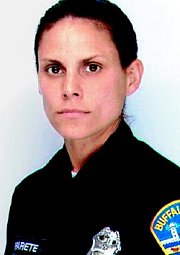
|
Officer Patricia A. Parete, clinging to life
Wednesday night after her spine was severed by a bullet, is
described by fellow cops as vibrant and "not one to
walk away from a police call."
Patricia A. Parete - one of two Buffalo
police officers shot Tuesday night - was fighting for her
life late Wednesday, her spine severed by a bullet fired by
a teenager who was on probation.
If Parete survives, she likely will be paralyzed from the
neck down.
"If she lives, she's probably going to be a
quadriplegic," said a fellow officer who spoke on
condition of anonymity. "I'm just so angry right now.
It's horrible."
Sources also told The Buffalo News that police believe
Varner Harris Jr., 18, who police say confessed to the
shootings, opened fire on Parete and her partner, Officer
Carl E. Andolina, because he feared being sent to prison now
that he is of legal age and no longer eligible for youthful
offender status.
|
| Officer Patricia A. Parete, clinging to
life Wednesday night after her spine was severed by a
bullet, is described by fellow cops as vibrant and "not
one to walk away from a police call. |
|
 |
Parete, the first female Buffalo police officer shot in the
line of duty, was listed in serious condition late Wednesday
night, while Andolina was in fair condition. Both are in
Erie County Medical Center.
Tuesday night, Parete and Andolina were
riding together on a special detail downtown investigating a
rash of car break-ins. At 9:01 p.m., they were dispatched to
a Valero gas station on the corner of Chippewa Street and
South Elmwood Avenue, where a fight had been reported.
The
officers spotted Harris running from the scene and chased
him in their cruiser.
They got out of their patrol car and ordered Harris to turn
around and take his hands out of his pockets.
They didn't know until too late that Harris was carrying a
gun.
|
Dennis C. Enser/Buffalo News
Erie County Medical Center trauma doctor Peter Ploch
describes where Officer Carl E. Andolina was shot, as Police
Commissioner H. McCarthy Gipson, left, and Mayor Byron W.
Brown listen. |
|
|
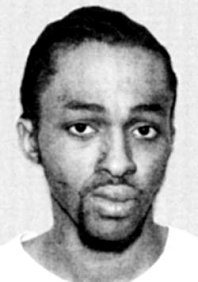
|
Harris "knew once the gun was found that he would go
back to jail and finish his time and he wouldn't be a young
offender anymore," a police source said. "He'd be
going to the men's jail."
Harris began shooting at the two officers, nearly emptying
the gun, as Andolina tackled him to the ground.
Neither officer discharged a weapon.
Parete was hit twice. Her bulletproof vest blocked a round
aimed at her chest, but a second bullet pierced her face and
ripped apart her spine.
As Andolina tackled Harris, he was hit three times - in the
neck, arm and chest, protected by his vest.
"Andolina
charged at him and took him to the ground," Police
Commissioner H. McCarthy Gipson said at a morning news
conference at ECMC. "He physically charged at an
individual who was firing at him at point-blank range. He
charged at a blazing gun."
At the news briefing, Mayor Byron W. Brown commended
Andolina's "heroic actions."
Harris was arraigned Wednesday morning in City Court, where
Judge David M. Manz entered a not-guilty plea on Harris'
behalf on attempted murder and weapons charges.
|
| Varner Harris Jr. was meeting the
requirements of his probation following his conviction last
year. |
|
|
Manz ordered Harris to remain in jail without bail and said
he will appoint a lawyer to represent him.
Law enforcement sources revealed Wednesday that Harris had
been arrested Jan. 24, 2005 - when he was 17 - for
attempting to rob a pizza deliveryman with two other youths,
one of whom had a gun.
He spent nearly two months in the Erie County Holding Center
before he was released on $5,000 bail.
His case came before the grand jury, and in May 2005, he was
sentenced to five years' probation as a youthful offender.
Police believe Harris may have bought the gun
used in Tuesday night's shootings off the street just a
couple of days ago to protect himself from former gang
members.
While Harris has a gang tattoo, he had "disassociated
himself with the gang," a police source told The News.
"But there was pressure to re-engage with the
gang."
Harris' 15-year-old girlfriend said he told her he was in
some sort of trouble and was carrying the revolver for
protection.
"It's hard for me to believe he was involved," the
girl said. "He's not violent. He didn't act
violent." The News is withholding her name because of
her age.
Family members, as well as probation officials and other
people charged with looking after him, said Harris had been
showing signs he was turning his life around.
He was enrolled in the day program at Hopevale School in
Hamburg, a program for seventh- through 12th-graders who
have run into trouble with the law or at their neighborhood
schools.
His mother, Theresa Moore, produced a report card that
showed his latest grades were in the 80s and 90s.
She said he had taken a liking to his home economics class
and brought home pies he had baked.
He also was an aspiring rapper and had recently recorded a
demo CD.
Harris, who is a week shy of his 19th birthday, came from a
troubled family. Records show his father, Varner Harris Sr.,
was arrested in 1989 in a series of violent home invasion
robberies of the elderly. He spent nearly three years in
prison and another three years on parole.
Probation officials said Harris had been under
"intensive supervision" following his conviction
last year.
"We were keeping a close watch on him because of the
nature of the crime," said George Alexander, Erie
County probation commissioner.
Harris always was at home as required when curfew checks
were made and was meeting with his probation officer as
scheduled.
Gregory Brice, director of the Bissonette House, who had
worked as a behavioral specialist at Hopevale, said Harris
was a quiet loner who was respectful to authorities.
"The Varner I know is a quiet, almost humble, and
respectful young man," Brice said.
"I was shocked when I read the paper and saw his
name," he said. "I know when I deal with him as an
authority figure, he was always respectful."
Moore said her son had been having behavioral problems
earlier in the year and was so prone to angry outbursts that
she took him to a doctor.
"He was acting up," Moore said. "Like when I
asked him to do something, he would just spaz out. I wanted
to know what the problem was."
The doctor prescribed Prozac, and Harris seemed to improve
on the medication, she said. But he didn't like taking it
and had recently stopped.
"If he was still taking [his medication], this probably
wouldn't have happened," his distraught mother said.
"One side of me believes it," she said of the
police shootings her son is accused of committing. "The
other side doesn't."
News Staff Reporters Michael Beebe and Matt Gryta
contributed to this report.
|
|
|
|
October Snow Storm 2006 |
|

Photo by RyanJK |
|

Photo by Raydizzle |
|
Youth Charged After Shots Are
Fired At Police
2 others arrested on city's East Side
The Buffalo News
By VANESSA THOMAS News Staff Reporter 10/11/2006
A 17-year-old youth has been charged with attempted murder
after two shots were fired at two undercover narcotics
detectives Monday night at Bailey and Minnesota avenues.
Jibreel F. Williams, of Greenfield Street, is accused of
firing the shots that narrowly missed Detectives Edward
Niemann and Timothy Mulhern. The plain-clothes detectives did
not return fire, and no one was injured.
The shooting marks the second time in about a month that
Buffalo police officers have dodged gunfire.
On Aug. 31, police said Basil S. Payne, 23, of East Amherst
Street, fired a single shot at two officers in Central Park
Plaza on East Amherst Street as he fled. Officers Corey Krug
and David Acosta did not return fire and captured Payne after
a foot chase.
"Obviously, they were in fear for their lives,"
Chief of Detectives Dennis J. Richards said of Niemann and
Mulhern. "When shots are fired, there's a potential for
anyone to be hurt, especially with officers being the
target."
"This once again demonstrates the dangers of police
work," he said. "The officers are just out there
doing their jobs and trying to rid the streets of
narcotics."
Police said the detectives, who were conducting a narcotics
investigation, spotted a group of men at Bailey and Minnesota
at about 10 p.m.
The detectives turned on the emergency flashing lights on
their unmarked car and turned west onto Minnesota.
"Jibreel was among those group of males on the corner. As
the car turned the corner onto Minnesota, Jibreel fired one
shot," Richards said. "And as [the detectives]
exited their unmarked vehicle, he fired a second shot."
The detectives chased the gunman, who, at times during the
pursuit, pointed a silver handgun at them.
Two other men who had been in the group on the corner also
fled. After a brief chase involving Northeast District
officers called in as backup, Narcotics Lt. Thomas Lyon and
Detective Sgt. Thomas Vivian arrested Williams and the other
two.
Williams has been charged with two counts of attempted murder
and one count each of criminal possession of a weapon and
obstructing governmental administration. Police said they
found a .22-caliber semiautomatic handgun in the rear yard at
the Minnesota Avenue home where he was apprehended.
Clayton Williams, 17, of East Ferry Street and Lisbon Avenue,
was charged with obstructing governmental administration and
unlawful possession of marijuana after police reported finding
three bags of the drug in his possession.
Philip Smith, 18, with addresses on South Division Street and
Minnesota Avenue, was charged with obstructing governmental
administration.
Police records show Jibreel Williams had been arrested April
23 on charges of using a loaded gun in a robbery.
That case was sent to a grand jury May 22, and City Judge
James A.W. McLeod released Williams on his own recognizance,
according to court officials. |
|
Bid to Use Police Phone Ends In
Weapons ChargeThe Buffalo News
10/7/2006
A 29-year-old Buffalo man who walked into the
Ferry-Fillmore District station early Friday morning to use
the telephone walked out in handcuffs after police discovered
a loaded .22-caliber revolver on him.
Jacobi O. Boyd of Carl Street walked into the station at about
4:40 a.m. and asked Lt. Richard Bartoszewicz to use the phone.
As a precautionary measure, Bartoszewicz patted the man down
and found the revolver, with three live rounds, in his jacket
pocket.
Boyd was charged with criminal possession of a weapon, a
felony. |
|
Two Arrested in Theft of 142
Parking Meters
By T.J. PIGNATARO
News Staff Reporter 9/29/2006
Two Camp Street men are accused of pilfering 142 parking
meters in downtown Buffalo recently and breaking them open to
loot them, city officials reported Thursday.
George Robinson, 46, and Terrence Miller, 30, of the same Camp
Street address, were charged with felony criminal mischief,
grand larceny and possession of burglary tools, according to
authorities, who said additional charges are pending. Acting
on a tip, Buffalo police - led by Detective Sgt. Thomas
Donovan - recovered as many as 40 meters and tools used to
open them Thursday morning at the home of Robinson and Miller,
according to a statement by Mayor Byron W. Brown. Both men
confessed to the crimes, authorities said.
Police found other meters dumped in several locations near the
Camp Street house.
"The missing parking meters were not only an
inconvenience to drivers, but it was also costing the city
money," Brown said.
How much money the city lost has yet to be determined,
officials said, but it is likely several thousand dollars.
Each meter can hold up to $60 in quarters. Replacing each
meter can cost between $300 and $450.
Police began probing the thefts earlier this month after
meters disappeared in several areas downtown, including
sections of Seneca Street near Washington Street and some
streets near the Buffalo Convention Center. One even was
stolen from Niagara Square in front of City Hall.
In many of the thefts, a saw apparently was used to cut the
meter pole. Vehicles also might have been used to yank the
meters down. |
|
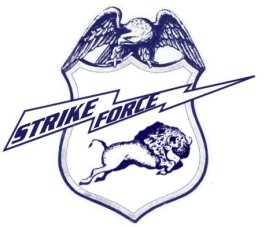 |
Strike
Force Hits Hard
Gipson says criminal activity
drying up
By GENE WARNER News Staff
Reporter
9/16/2006
Two 16-officer squads of Buffalo
police have been operating in targeted neighborhoods since
mid-August in a crackdown on gang-related activity and other
violent crime.
While Operation Strike Force
already has logged 589 arrests, Police Commissioner H.
McCarthy Gipson found another way to describe the
impact on these high-crime "hot spots."
"After about two days in an area, we've discovered
that the criminal activity dries up," Gipson said.
"People are saying you can't score drugs in there." |
| During a City Hall press conference
Friday, Mayor Byron W. Brown called this an important effort
to reduce crime, eliminate gang violence, remove illegal guns
and drugs and support law-abiding citizens.
The mayor also delivered a stern message to criminals:
"Go straight, get out of town or give yourself
up."
The strike force, operating since Aug. 14, targets a
roughly 10-to-12-block area for several days, sending one of
two 16-officer teams into the neighborhood from 4 p.m. to 2
a.m.
Unlike regular patrol officers, who basically respond to
911 calls, these strike-force officers actively search for any
criminal activity in the targeted areas. Gipson said
strike-force members are cracking down on anything that's
illegal and not nailed down.
"We want them to be mobile, agile and slightly
hostile," the commissioner said.
In the strike force's first 31 days, it made 589 arrests,
or 19 per day; issued 2,095 traffic summonses; impounded 408
vehicles; confiscated 28 guns; and seized $19,857 in cash.
The initiative also has brought in more than $78,000 in
revenue, through traffic tickets, towing and other fines and
fees.
A staple in the operation is the use of a "mobile
plate hunter," a computer-sized device with infrared
cameras that quickly scans license plates heading in either
direction. The license plates are checked against lists of
stolen cars, uninsured and unregistered vehicles, and cars
owned by people wanted by police.
The commissioner was asked about the two recent shootings
of armed suspects by strike-force officers.
"These are circumstances where people pointed guns at
police officers," Gipson replied, adding he would defend
any officer acting in self-defense.
The targeted areas are picked using crime-mapping
information from police crime analysts, internal intelligence
reports and input from the department's district chiefs.
The targeted areas in all five city police districts
include: Broadway-Fillmore, Grant-Ferry-Hampshire,
Grant-Congress, Bailey-Alma, Fillmore-Leroy and
Seneca-Babcock.
Officers in the 34-member unit come from each of the city's
five police districts and the department's Flex Unit. |
|
|
| Police Commissioner H. McCarthy Gipson
Will Be Off Duty For Six Months On Medical Leave,
Deputy Commissioners Byron C. Lockwood And Daniel
Derenda Will Split Commissioner Duties In The Interim |
|
|
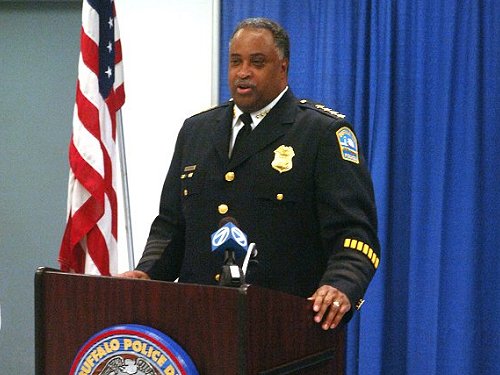
|
|
Police Commissioner H. McCarthy Gipson |
|
News of Gipson's Illness Stuns Colleagues
Head of city police taking leave to begin treatment for
"moderately aggressive' form of prostate cancer
By VANESSA THOMAS and BRIAN MEYER
News Staff Reporter 8/22/2006
Buffalo police officers, usually hardened by the tragedy
they see on their jobs, were numb, somber and crying Monday
when news spread that Police Commissioner H. McCarthy Gipson
has prostate cancer.
Gipson, 58, sent shock waves across the city when he
announced Monday morning that he has a "moderately
aggressive form of cancer" but insisted that the
prognosis is "very good" and expects to return to
his job after his recovery. He is taking a medical leave to
undergo radiation treatment.
Gipson, a well-respected law enforcement veteran of 35
years, has been the city's top cop for the past 61/2 months.
Several police officers openly wept when they learned about
Gipson's health problems, while Common Council members and
community leaders were equally stunned and saddened. |
|
|
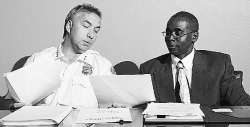
|
"He's
always been a big, strong guy - real positive - and that
will be the type of thing that will carry him through
this," said Lt. Margaret Sack, a colleague of 25 years.
"He's the best police commissioner we've had in my
career. He's focused on getting the bad guys off the street
and getting drugs off the street, and cops are happy to be
cops again.
"Hopefully, he'll be brought back to us sometime
soon," she added. "This is a real blow for
us."
Gipson said he will begin five weeks of radiation in
mid-September. He was diagnosed with prostate cancer July 29
after he began experiencing health problems in late April. |
| Deputy Commissioners Daniel Derenda and
Byron C. Lockwood |
|
Gipson will be on a family medical leave,
approved by the city, which means he can be away from work
for up to six months - unpaid - but he keeps his fringe
benefits, according to Corporation Counsel Alisa A.
Lukasiewicz.
Gipson's disclosure came on the heels of a controversy over
his delay in establishing residency in the city. The City
Charter requires mayoral appointees to establish residency
within six months of taking office, so Gipson received
Common Council approval for an extension that gave him until
Monday to move into Buffalo from his home in East Amherst.
Gipson said he was looking into a medical-related extension
to the residency waiver, but legal experts told him there
was no such provision, which contributed to his decision to
take a medical leave.
In Gipson's absence, the Buffalo Police Department will be
run by the two deputy police commissioners who will share
Gipson's duties.
Mayor Byron W. Brown's decision to have the two police
deputy commissioners - Byron C. Lockwood, first deputy
commissioner of administration, and Daniel Derenda, deputy
commissioner of operations - run the department in their
current positions means the Common Council would not have
the authority to confirm an acting commissioner.
Under the new plan, Lockwood will assume all management
duties, while Derenda will handle external communications.
"Mac will be back here in the near future, so we'll run
the department status quo until he gets back," said
Derenda, referring to Gipson by his commonly used nickname.
"We'll run everything past him, and I'll call him and
get his approval. Really, nothing has changed. As far as I'm
concerned he's still the police commissioner."
Lockwood stressed that the city's criminals should still be
on edge because the crime-fighting initiatives will
continue.
"Let's make no mistake here, the pressure is not going
to let up because the commissioner is sick," said
Lockwood. "We're going to stick with the same strategic
plan to combat crime."
Delaware Council Member Michael J. LoCurto praised Gipson's
involvement in neighborhoods, noting the commissioner
attended many public events. "He does a good job with
the public and has been pretty accessible," said
LoCurto.
Some community leaders who are on the front lines of
combating violence praised Gipson's term at the helm.
"Commissioner Gipson and I have a great
relationship," said Dwayne Ferguson, president of MAD
DADS, an anti-crime organization. "He is up to date on
things and is always right on point about the things he
hopes to change."
Back at the Police Department, many rank-and-file officers
and police officials were offering their well wishes and
eagerly awaiting his return.
"I think first and foremost, his health is the most
important thing," said Central District Police Chief
Donna M. Berry. "His leadership skills have really
rubbed off on a lot of people. Of course, we'll miss him,
but I think we can hold down the fort until he comes
back." |
|
|
|
| Police Take
High-Tech Aim At Drivers Who Keep Secrets
By VANESSA THOMAS News Staff Reporter
7/31/2006
The Buffalo police will soon begin using a
new tool to find lawbreakers - a gadget
capable of scanning your license plate and
revealing all your traffic infractions and felony
warrants in milliseconds. |
 |
|
In the blink of an eye, the license plate
reader can zap your license plate and check it against
criminal hot lists.
If there's a hit, the reader's screen flashes red and it
reveals, in words, any crimes or infractions tied to that
vehicle - including fugitives, outstanding warrants, parole
violators, sexual predators, stolen vehicles, revoked and
suspended driver's licenses, expired registration, stolen
license plates, parking violations and Amber Alerts.
Police officials expect to begin using their two new
license plate readers across the city
within the next few weeks.
"If you haven't paid your parking or traffic tickets or
kept your insurance up-to-date, this
machine will catch you," said Traffic Lt. Thomas J.
Masterson.
Police plan to use the license plate readers during traffic
checkpoints, neighborhood
clean-sweep programs and other crime-fighting
initiatives.
Top police officials say they are mindful that some citizens
may view the new license plate
readers as Big Brother watching over Buffalo's drivers, but
they stressed that the machines
will be used within the bounds of the law.
"It is Big Brother watching, but technology brought us
here. Technology like this can assist
law enforcement tenfold," said Inspector Joseph F. Strano,
who is in charge of the police
department's administration and communications. "Those
individuals who are abiding by
the rules of the road will just continue on their merry way,
but if you're not abiding by the law,
you stand to get caught."
The Buffalo Police Department purchased one license plate
reader for an estimated
$20,000, but the cost is being covered entirely by a state
grant. A second reader was
donated to the Buffalo police by the state's Department of
Criminal Justice Services.
The machine is so advanced, manufacturers say, that it can
scan license plates of parked
and moving vehicles almost anywhere on the street - vehicles
on both sides of the roadway,
vehicles driving toward the machine, and vehicles driving by
the machine. It can even read a
parked or moving car across four lanes.
"They also say that these readers can get a car coming at
you at 150 miles an hour,"
Masterson said. "Once you get close to us, it's too
late."
For the last four months, the Buffalo Police Department's
Traffic Unit has been quietly
practicing on the public using a borrowed license plate reader
from the State Police.
From April 6 to July 5, Buffalo police conducted seven traffic
checkpoints across the city with
the assistance of State Police and the U.S. Border Patrol.
During that period, the license
plate reader helped Buffalo police issue more than 270 traffic
summonses to motorists.
"We've been in every police district in the city since
April," Masterson said. "We picked some
streets where residents had complained like Parkside, near
Florence Avenue. We're always
getting complaints from residents there about speeding and
people running red lights.
People were cheering when we were out there."
During the four-month trial, no serious criminals were
arrested. The traffic summonses
included a Kenmore man whose driver's license has been
suspended since 1983, the
driver of a private dump truck who was driving with suspended
license plates, and the driver
of a truck loaded with medical waste whose insurance had
expired. |
|
|
|
Gerald W. Schoenle Named Police Chief at
University at Buffalo
By JAY REY BUFFALO NEWS STAFF REPORTER 7/11/2006
A native son is returning to the region to be the
University at Buffalo's next police chief.
Gerald W. Schoenle Jr., a retired Buffalo police captain
currently working as an assistant police chief in Arlington,
Texas, will take over as chief of police at UB on July 31,
officials said Monday.
Schoenle, 50, will replace John M. Grela, who is retiring from
the university after 33 years, the last 15 as its police
chief. Grela will stay on at UB until Oct. 31.
"The position is very appealing to me. I like the
university setting a lot," Schoenle said Monday by phone
from Texas. "I just feel it's a really good fit for me,
and this would be a nice way to finish up my career."
Schoenle started with the Buffalo Police Department in 1980,
rising from a patrol officer to the rank of captain of
communications and administration when he left in 2000.
Schoenle taught many of the area's officers at the police
training academy, where from 2000 to 2005 he served as
director of public safety training for Erie County Central
Police Services.
He then applied for the job in Arlington - a city of nearly
360,000 people - where he has been an assistant chief since
May 2005.
Schoenle still was in the process of moving his family from
Eggertsville to Texas, when the opportunity came up at UB.
As UB's police chief, he will oversee 61 sworn officers, who
patrol the North and South campuses, where, like other college
campuses, the majority of reported crimes are theft and drug
and alcohol violations.
Schoenle was selected by a search committee, which considered
more than 100 applicants from around the country, said Dennis
R. Black, vice president for student affairs.
"The committee found that his mix of local knowledge, his
demeanor and his willingness to be an innovative leader made
him the ideal choice for this important position," Black
said.
|
|
|
|
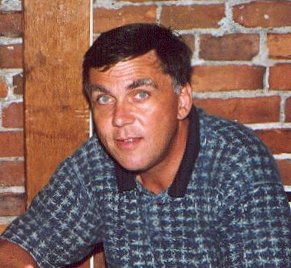 |
Detective
Mark R. Stambach Retiring Homicide Detective Grateful to his
Mentors
By LOU MICHEL BUFFALO News Staff Reporter 6/25/2006
Stanley Sherry stood up from his chair in the homicide
interrogation room at Buffalo Police Headquarters and got in
the face of Detective Mark R. Stambach.
"You're accusing me of murdering my sister," Sherry
yelled in the detective's face.
"Yes, I am," Stambach answered softly.
This is the intense world Stambach, the city's longest
tenured homicide detective, has lived in. He is retiring today
after nearly two decades of cajoling, tricking and frightening
murder suspects into admitting their deeds.
And despite all the lies and gruesome scenes he |
| Detective Mark R. Stambach Homicide Squad |
|
| has encountered, Stambach says he loved every
day of his work, even if some involved dodging bullets and, in
one instance, fatally shooting an armed robbery suspect.
Homicide investigations represent "the World Series of
police work," he says, because no crime is more heinous
than taking a life.
Assigned to hundreds of murder investigations, Stambach, 56,
is quick to give credit to those who helped him learn his
craft along the way.
His mentors, as he calls them, include five "old
school" gumshoes, Bob Grabowski, Dan DiPirro, Melvin G.
Lobbett, John Ludtka, all retired, and the late Eddie Gorski.
They taught him that homicide detectives "speak for the
dead" and that the first witness you interview is the
crime scene.
"It talks to you," he said.
And the third lesson: Solving a murder is always a team
effort.
That was the case last year when Sherry angrily denied killing
his sister, Valerie Georgeff, in the Sobieski Street home the
siblings shared.
While Stambach continued his interrogation of Sherry,
Detectives Mark Vaughn and James Lema were phoning in
information that they found no signs of forced entry into the
house and that the beating death indicated it was personal -
someone who probably knew the victim.
At the same time, Detectives Reginald Minor and Patrick Judge
were able to disprove Sherry's alibi of being with his
girlfriend at the time of the killing.
Stambach shared what the other detectives had learned and
then, matter-of-factly, informed Sherry he would be charged
with second-degree murder.
"He sat back down and stopped screaming," Stambach
said. "I said "Stanley, you're going to have to tell
me what happened. I don't want to charge you with murder.'
"
But Sherry wasn't ready to make an admission.
Stambach tried another tack.
He asked the 54-year-old Sherry what he would miss most when
he was sent to prison for the next 25 years.
"A fish fry," Sherry said. "I love my Friday
night fish fry."
Stambach pounced on the opening.
"I'll tell you what, we're going to stop right now and
have dinner together. I'm going to order out two fish
fries," said Stambach, who wasn't even hungry.
After eating the fish fries a patrol officer delivered,
Stambach stared at Sherry and broke the silence.
"You're going to have to tell me what happened," he
said.
Sherry lowered his head.
"I did it," he said. "I killed my sister."
He beat her up, Sherry explained, because the 65-year-old
woman had been picking on him.
Sherry also admitted to having a drug problem and that the
tension between him and his sister had been building for some
time. Stambach calmed Sherry and told him that he would be a
witness for Sherry at his murder trial.
The offer was genuine. Stambach later told the jury exactly
what Sherry had told him.
"In actuality, I was a witness against him," the
detective said.
The trial ended with Sherry convicted and sent to prison for
25 years to life.
When defense attorneys criticize Stambach's interrogations
that have landed their clients behind bars, Stambach has a
standard answer: "I didn't commit the crime. My job is to
investigate and find the murderer."
Lt. Kenneth M. Bienko, chief of homicide squad, says Stambach
was a key investigator, a go-to guy in tough cases.
"He's definitely a great interviewer. He was a piece of
the puzzle, and it's tough rearranging the puzzle now that
he's left," Bienko said.
Even some defense lawyers give Stambach good reviews.
"He's absolutely the most fair, even-handed person who
ever worked in homicide. Mark doesn't hide the truth. He
doesn't try to hide facts favorable to your client. I wouldn't
say that about everybody," attorney Leigh E. Anderson
said.
So what will Stambach do in retirement now that he isn't
getting murderers to confess?
"Read detective novels," he said. "It's my
favorite pastime." |
|
|
|
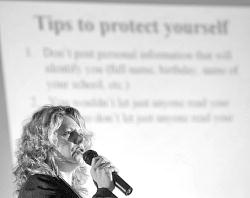 |
Police
detective pursues on-line sexual predators
By ANTHONY CARDINALE
BUFFALO News Staff Reporter 5/17/2006
Most sex offenders are between 25 and 45 years old, but
Detective Sherry L. Kiszewski has received child pornography
on her computer from predators of all ages, including a
15-year-old boy.
The Sex Offense Squad detective explained the ins and outs of
her undercover work in cyberspace for 25 parents Tuesday
evening in Southside Elementary School.
Posing as 14-year-old "Danny," the detective said,
she logged on to a chat room and got an instant message from
someone named "Tommy."
Asked what Danny was interested in, the detective replied
that Danny was curious about men and women, but unsure of what
he liked. Tommy replied that Danny was too young for this chat
room and should exit |
| Detective Sherry Kiszewski reviews a list of
tips for parents to follow to keep Internet predators from
preying on their children.
PHOTO Derek Gee/Buffalo News |
|
But two weeks later, when Danny was back in the
chat room, Tommy struck up a conversation: "Hey, what are
you doing? Want to come over and have some fun with me?"
Tommy agreed to pay the cab fare for Danny to visit him,
posing as Tommy's nephew.
Borrowing a cab from the police garage, Kiszewski did the
driving and someone else sat in the back seat as the young
passenger. They stopped outside an apartment house.
"I see this little old man with gray hair and a cane,
trying to run to the cab door," Kiszewski recalled.
"He gets to the door, and I say the fare is $8.50. He
hands me a 10 and says, "Keep the change - where is he?'
"
The old man was arrested.
Another sex offender did all the driving - for 26 hours from
the Midwest - for a rendezvous with a 13-year-old girl in
Cheektowaga. He kept in touch with her all the way with text
messages from his cell phone.
The girl's father, already suspicious about her computer
habits, had called Cheektowaga police, who traced the origin
of the messages and found the man's van at a Williamsville
motel. In his room they found candy and a card for the girl,
and a laptop computer set up to play her favorite song. He was
arrested.
The same girl tipped officers off to a Grand Island man,
Jeffrey Hart, 27, who also was pursuing her on-line. Kiszewski
chatted with him for six months and finally met him in a
market at Grant and Amherst streets.
After his arrest, the former Town of Tonawanda teacher said
from a federal prison: "The day they arrested me, I
realized what I had become, a monster."
The detective offered parents this advice:
Don't be afraid to spy on your children by keeping their
computer in the dining room or by tracing their Internet
activities with special software.
Don't let them e-mail full name, date of birth, school and
home address to anyone they don't personally know.
Watch for telephone calls, letters or gift packages from
people you don't know.
If you see an on-line account on your computer that you didn't
open, chances are it's being paid for by somebody stalking
your child.
Report suspicious activities to the FBI, 856-7800, or to
Kiszewski, 851-4495, ext. 238.
Community Police Officer Anthony V. LeBron, who arranged the
event, said Kiszewski was trained by the FBI and uses its
program, but the Sex Offense Squad soon will develop its own
program to offer local communities. |
|
|
|
7 officers receive Edward H. Butler Awards
for Heroism
Reprint Buffalo News 5/12/2006
Two groups of Buffalo police officers who were able to take
gun-wielding suspects into custody without incident received
the highest honor awarded at the annual dinner of the Buffalo
Police Benevolent Association.
The dinner was held Friday night in Salvatore's Italian
Gardens in the Town of Lancaster.
Edward H. Butler Awards for Heroism, named after the founder
of The Buffalo News, were presented to Lt. Michael McCarthy
and Officers James Hosking, Earl Perrin and Mark White
of the Northeast District, and Officers Ronald Clark, David
Daniels and Thomas Moran of the Ferry-Fillmore District.
Both groups of officers also received Officer of the Month
recognition in 2005 for their respective cases.
It was Dec. 7 when Northeast District officers spotted the man
suspected of shooting at an officer during an attempted
traffic stop months earlier. Perrin and White, traveling in an
unmarked car, saw the suspect take a gun from the passenger of
a van on East Ferry Street.
Following a foot chase through the neighborhood, and from the
rooftop of a delicatessen to the upper porch of a neighboring
apartment house, officers cornered the suspect in the upper
apartment, where he was subdued after a struggle.
During the chase, the suspect had pointed a gun several times
at pursuing officers. It later was determined that the weapon
was loaded and had misfired.
The Ferry-Fillmore District officers interrupted an attempted
armed robbery July 13 at a store and caught the fleeing
suspect.
Moran and Clark had seen a man, his face covered by a blue
bandanna and a gun in his hand, run into a store at Sycamore
and Herman streets. As they approached, they saw him pointing
the gun at several patrons and employees.
Drawing their weapons, Moran and Clark ordered the suspect to
drop his. The suspect fled through a back door with the
officers following.
Daniels headed off the suspect a few doors down. Officers
tackled and subdued the suspect, and recovered the gun.
Other officers honored were:
Detective George Dougherty Award - Detective Martin Bayerl.
An officer since 1968 and a detective since 1986, Bayerl has
worked in the Burglary Task Force, Northeast and South
districts before his current assignment to the Northwest
District.
Treating each case and victim with equal importance, Bayerl
has succeeded through tenacity rather than notoriety,
substituting thoroughness for hastiness. He is the consummate
district detective who epitomizes officers who work in
relative obscurity but are indispensable to law enforcement in
Buffalo.
Lt. George Howes Award for Leadership - Lt. Michael
McCarthy.
A police officer since 1993, McCarthy was promoted to
lieutenant in 2000 and given his current assignment in the
Northeast District.
He has demonstrated leadership qualities throughout his
career, best exemplified when he guided his emotionally
devastated platoon through the unexpected deaths of two
colleagues in recent years.
Butler Award for Citizens - William Lepere
Northwest District officers were looking for a bank robbery
suspect the morning of Nov. 14 when Lepere, who was driving
by, saw Officer Linda Wilson scuffling with the suspect.
Lepere stopped to help Wilson, and when the suspect broke
loose, Lepere and Wilson followed him. Lepere wrestled the
suspect to the ground and continued to struggle with him until
additional officers arrived.
Lepere later found the stolen money in the grass and turned it
over to police.
Butler Award for Service - Betty Lou Young
She started working for the department's federal credit union
as a summer job at age 14; at 80, she still puts in a full
week.
The daughter of a police officer who was among the credit
union's founders, Young finished high school at night and
attended continuing education twice a week until she was 16.
The decades have passed, the credit union has moved around,
commissioners have come and gone, but Young has remained. She
is an institution herself.
Police Officer Achievement Award - Officer Dave Greenway
A police officer since 1982, this former Marine is known for
building cases that hold up through the legal system,
realizing that arrests are only the beginning of the process.
Officers know that beneath his quiet exterior, there's a
wealth of knowledge and a sincere dedication to duty.
Also a Coast Guard reservist, Greenway served active duty in
Operations Desert Storm and Iraqi Freedom. Despite myriad
accolades, he most values his service to others.
Officer of the Month award winners for 2005:
January - Officer Raymond Krug helped the Sex Offense
Squad investigate a December 2004 sexual assault, working the
streets to learn the suspect's real name and whereabouts, and
staking out a Hopkins Street home for three days to make the
arrest Jan. 25.
February - A gun was drawn on officers Thomas Duffy, Ronald
Jentz and Steven Schulz on Feb. 24 while they checked out
a report of someone selling drugs from a vehicle on Carolina
Street. They subdued the man and took away the gun.
March - Officers James Panus and Barbara Walz followed
footprints in the snow across several blocks March 20 to
locate two suspects from an armed robbery at an East Delavan
Avenue restaurant. The suspects' gun and ski masks were
recovered.
April - Officers Steven Alvarez, Thomas English, Thomas
Starkey and Michael Sullivan tracked down and arrested a
suspect who had opened fire April 17 on English near the
corner of Genesee and Rogers streets. A gun was found in a
nearby back yard.
May - Officers Greg Handgis, Mitchel Mayer and Terrence
Supples chased and caught two men suspected of robbing a
McDonald's restaurant on Elmwood Avenue on May 14. Almost
$1,000 cash and a loaded handgun were recovered.
June - Officers Steven Alvarez, James O'Donnel, Anthony
Sisti, Sandra Sisti and Robert Skrabacz responded to a
report of a violent domestic argument June 28 on Seneca Street
and encountered the suspect, who pointed a rifle at them. One
officer grabbed the rifle while another tackled the suspect.
July - Officers Ronald Clark, David Daniels and Thomas
Moran.
August - Detectives Denise Crawford and Mary Gugliuzza,
using a "paid" sticker from a 20-pound bag of rice
used to weigh down a suitcase containing the remains of a
homicide victim, tracked down the victim's identity and
charged the victim's son and another man with murder.
September - Officers Michael Divito, John Kaska and James
Panus, responding to a Sept. 30 report of a robbery
suspect in the Newburgh Avenue area, arrested five suspects in
a series of street robberies in the district. Two handguns
were recovered.
October - Officer Thomas Sercu, from routine traffic
stops and his own observations during 14 shifts, recovered
more than two pounds of cocaine, 16 pounds of marijuana,
$43,500 in cash and a loaded handgun. The recoveries led to
nine arrests and the confiscation of several vehicles.
November - Officers David Cieply, Robert Lee and Thomas
Moran had responded Nov. 2 to a homicide on Domedion
Street, where one of the officers learned of a man with the
victim's property. Officers found him; he subsequently was
charged with the murder.
Also, Northwest District Officer Linda Wilson,
responding to a reported bank robbery on Amherst Street on
Nov. 14, checked out possible escape routes and spotted the
suspect. Wilson struggled with the suspect and, with the help
of a passer-by and another officer, was able to subdue and
arrest him.
December - Lt. Michael McCarthy and Officers James Hosking,
Earl Perrin and Mark White. |
|
|
|
 |
Narcotics/Homicide
Tip Line
4/22/2006
The Buffalo Police Department's new Narcotics/Homicide Tip
Line.
The number is 847-2255.
It is different from other tip lines in that it will be
staffed by a civilian member of the Police Department during
the day.
People calling in might feel more comfortable talking to a
live person, who is trained to ask questions, Police
Commissioner H. McCarthy Gipson said Friday.
It is hoped to eventually have the line staffed around the
clock, but in the meantime callers can leave information if
the line is not staffed. All information will be kept
confidential, Gipson said. |
|
|
|
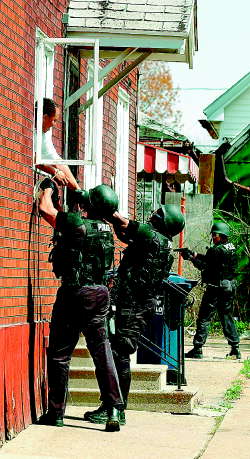 |
3 Days of Secret
Police Drug Raids Bring 78 Arrests Throughout City
Street-level dealers targeted in sweeps
By T.J. PIGNATARO and VANESSA THOMAS
BUFFALO News Staff Reporters 4/21/2006
A loud "flash bang" concussion device is detonated
inside a Kensington Avenue house as Buffalo Police SWAT
officers, clad in black armor and brandishing automatic
assault rifles, storm a lower apartment.
"Buffalo Police. Search warrant. Buffalo Police,"
the officers yell to the now temporarily stunned occupants
inside.
Within seconds, there are multiple shotgun blasts. At the same
instant, another officer cradles a 1-year-old boy out the
front door and down a flight of steps to safety.
When the smoke clears, three large pit bull terriers lay dead,
in pools of their own coagulated blood. Five people are in
handcuffs. They're among the latest of the 78 people arrested
on drug charges during a three-day crackdown on narcotics
sales across the city.
The drug busts, dubbed "Operation Shock and Awe,"
began Tuesday and are believed to be the first time the
Buffalo Police Department has tried secret, consecutive raids.
By the operation's conclusion Thursday evening, police had
seized about six pounds of marijuana, seven ounces of crack
cocaine, five guns and more than $11,000 in cash. In all, they
executed 38 search warrants in every corner of the city. |
|
"We are declaring war on street-level drug
dealing," said Police Commissioner H. McCarthy Gipson as
he drove a Buffalo News reporter to the site of a raid
Thursday.
"The reason for the secrecy is that we didn't want the
drug dealers to know that we were coming," he added.
"This has put a dent in the drug trade, put some
operations out of business and addressed the fears of some of
the residents. These residents are glad to see us taking
action against drug dealers."
Besides cracking down on street-level drugs, police said the
raids were designed as a means to interview the suspects about
recent homicides or shootings. "This is not just about
drugs," Narcotics Lt. Thomas R. Lyon said. "A lot of
drug dealers have knowledge about violent crimes. Either
they've heard who committed a shooting, or they were part of
it, or they have heard rumors about who did the
shooting." |
|
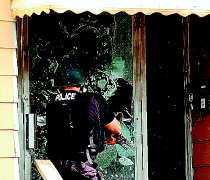 |
The
multi-agency operation was headed by Buffalo's Narcotics Unit
and SWAT Team assisted by Amherst's SWAT Team and Flex Unit
and the State Police SWAT Team.
The drug bust was headed by Deputy Police Commissioner
Daniel Derenda; Chief of Detectives Dennis J. Richards; Flex
Unit Inspector Michael F. Gaspar; Capt. Mark R. Maraschiello,
SWAT commander; as well as narcotics unit lieutenants Lyon,
John C. Eberhart and Steven J. Nicosia.
Mayor Byron W. Brown is expected to hold a news conference
today announcing the formation of the Buffalo Police
Department's new narcotics tip line for residents to report
illegal drug activity.
On Thursday, reporters and photographers observed four raids -
at 95 Wohlers Ave., 61 Koons Ave. and lower apartments at 427
Grant St. and 1350 Kensington Ave. Other raids were conducted
at 341 15th St., 97 Fay St. and 317 Jewett Ave.
In the afternoon raid at 61 Koons, SWAT officers smashed the
wooden front door and rushed inside. One occupant tried to
jump from a second story window, but officers pulled him back
inside, his arms flailing. |
Bill Wippert/Buffalo News
Suspect Youthers Greer, above left, is restrained by Officers
Martin Motley, left, and Earl Perrin as he tries to escape
through a kitchen window during a raid Thursday on Koons
Avenue. Below, Officer Motley smashes a glass door to gain
entry for a house raid on Grant Street. |
|
Two video cameras were hidden inside pine trees
on the lawn in front of the quaint two-story brown brick
house. They're part of a sophisticated video surveillance
system set up to allow drug dealers inside to track the
movements of their customers and police.
"This is very high-tech. We don't see this very
often," said Detective David Sugg, after police tore down
the wires attached to the cameras, disconnecting the
surveillance system, which was no match for the speed of
Thursday's raid. "Those cameras can see all the way down
the street - both ways - so they can decide who they want to
sell to."
The blitz concluded shortly before 9 p.m. Thursday. In
addition to the seven houses raided Thursday, 15 search
warrants were executed Tuesday with 31 arrests. Sixteen more
were completed Wednesday, yielding 34 more arrests.
Tuesday's raids included: 126 St. Louis St., upper and lower;
15 Ivy St.; 39 Woltz Ave.; 348 Winslow Ave., lower; 76
Swinburne St., lower; 130 Sears St., lower; 90 Lombard St.;
696 Hopkins St., rear; 270 Parkdale Ave., upper; 330 Parkdale
Ave., lower; 7 Langmeyer Ave.; 56 C. St.; 359 Bissell Ave; and
39 Laurel St.
On Wednesday, police raided 13 Dart St., upper and lower; 34
Goemble Ave., upper; 111 Goemble Ave., upper; 188 Coit St.;
1399 Broadway, lower; 25 Rommel, lower; 1245 Sycamore St.,
lower and upper; 91 Koons Ave., lower and upper; 122 Gibson
St., lower; 225 Smith St., upper; 148 Breckenridge St.; 196
Albany St., lower; and 109 Gittere St., upper. A street-level
patrol arrest for 3.5 pounds of marijuana and more than $5,000
cash was also made at 2317 Bailey Ave. on Wednesday, police
reported.
"The word out on the street is that Buffalo is very hot
with narcotics raids and no one knows who is going to be
next," Sugg said. |
|
|
|
| Buffalo Police Doing More Than Writing
Tickets
By DAN HERBECK BUFFALO News Staff Reporter
3/14/2006 |
|
|
|
| Traffic summonses, arrests overall up in two
months
Frustrated over frozen wages, Buffalo police officers
handed out a huge number of parking tickets during the first
two months of this year.
The ticketing blitz had the whole community talking. Many
people were upset.
But that wasn't all city cops did during January and February.
Traffic summonses and overall arrests also were all up
significantly over the same period in
2005. Driving-while-intoxicated arrests jumped by 40
percent. And the number of calls police officers responded to
increased.Regardless of the reasons behind them, Police
Commissioner H. McCarthy Gipson sees the numbers as a good
sign.
"Pump up the volume," Gipson said. "I want to
see officers more involved and more engaged in their work.
From everything I can see, that's what is happening. |
|
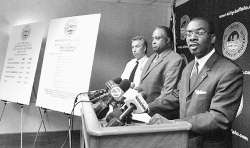 |
"If I
thought the officers were giving parking tickets and
neglecting their other duties, I'd be all over them. But that
isn't the case."
According to Gipson, Mayor Byron W. Brown and police union
President Robert P.Meegan Jr., this is the way it's going to
be in Buffalo from now on.They say the city has begun a
zero-tolerance policy on crime - especially drug-related
crimes.
The city plans to arrest more drug dealers and more drug
customers. In some cases, officers will seize the cars of
suburban residents who come to the city to buy crack and other
drugs.
Illegal parking, DWI, speeding and other traffic infractions
that many cops might have been winking at in the past no
longer will be tolerated in the city, Gipson said. |
Dennis C. Enser/Buffalo News
Mayor Byron Brown, right, spoke Monday about the Buffalo
Police Department's new zero-tolerance policy. With him are
Commissioner H. McCarthy Gipson, center, and Deputy
Commissioner Daniel Derenda. |
|
"It isn't for me to say why these things
weren't enforced as strongly as they could have been in the
past," Gipson said. "I can only talk about what I
plan to do."This is a new day for this department,"
Gipson said.
The union president agreed.
"The city has been the playground for people from the
suburbs long enough," Meegan said.
The performance of police in the first two months of Brown's
administration raises a number of questions:
Is it an actual law enforcement crackdown or just a
temporary uptick in activity fueled by anger over the wage
freeze imposed on police by the control board?
Will the crackdown end as soon as the Police Benevolent
Association has its first few disagreements with the new mayor
and commissioner?
Who really runs the department - the commissioner or the
union?
If city cops can pack this much work into two months, why
haven't they done it before?
Praise for police
Some city residents, like Rudolphus Boans Jr., are thrilled
with what they've seen so far, especially after hearing Gipson
and Brown outline their Zero Tolerance Action Plan last week.
"I hope the police keep it up, because the city needs
it," said Boans, vice chairman of the city's Stop the
Violence Coalition. "If you take care of the smaller
things, like people gambling on street corners, you might have
an effect on bigger things, like homicides. Enforcing the law
on these quality-of-life crimes is long overdue."
Others, like James Ostrowski, president of the grassroots
group called Free Buffalo, are skeptical. Monday, Ostrowski
said he thinks the parking crackdown is already winding down.
"It's still a renegade police force," Ostrowski
said. "If we have a drastic policy change like this
coming from the union and rank-and-file officers, who is
running the Police Department?"
Gipson said he wants police officers to use common sense and
discretion in their enforcement of the law, but he wants that
enforcement to be very strict when it comes to drugs and
street crimes.
He said he wants officers to be much stricter than they have
been in the past in enforcing traffic and parking regulations.
"There are people who want me to chastise officers for
giving tickets, for doing their jobs," Gipson said.
"I won't do that."
If officers were ticketing legally parked cars or illegally
targeting certain people for harassment, Gipson said,
"that would be different."
Exactly who started the crackdown? Finding the answer is a
difficult task.
Ostrowski believes it is a union-backed protest action that
will be short-lived. And he said it's wrong to let the union
and cops on the street determine the city's law enforcement
objectives.
Meegan said he did not start it, but he supports it. He said
it all began with a few street cops, whom he would not name,
and then spread like wildfire through the department.
"People keep fingering Bob Meegan and company, but the
officers on the street are frustrated," Meegan said.
"They've gone 20 months now without receiving a raise
that was contractually agreed upon with the city.
Although the crackdown started weeks before Gipson took office
on Feb. 13, he and the mayor claim it was a logical response
by officers to Brown's campaign promise of "no
tolerance" law enforcement.
New spirit
Gipson said he and the mayor have reached out to the police
union, trying to improve relations that had become testy
during the administration of Mayor Anthony M. Masiello and his
police commissioner, Rocco J. Diina.
"I would like to think the police officers are wildly
excited about the new leadership," Brown said.
According to some officers, Gipson, a respected former street
cop, has brought a new spirit of cooperation to the
department.
"Bob Meegan doesn't run the department. The commissioner
does," said Traffic Lt. Thomas J. Masterson, who started
police work in 1963 and is the department's senior member.
"The new mayor and commissioner are trying to deal fairly
with [officers], and I think the guys in the street appreciate
that."
Officers appreciate that Brown has tried - unsuccessfully so
far - to lift the wage freeze imposed by the state financial
control board that oversees the city's finances, Meegan said.
"The rank-and-file officers are excited about our new
commissioner and mayor," said Detective Christopher R.
Dates of the Northwest District. "We had poor morale
under the previous administration. This is a fresh start.
Hence, you're seeing some very hard work being done."
Time will tell whether the stepped-up enforcement of the past
two months becomes permanent. Meanwhile, the city will have to
deal with some public relations problems relating to the
parking ticket blitz.
"I talk to a lot of residents and business people, and
the overwhelming response I'm getting is that it's hurting
people and hurting businesses," said Justin Azzarella,
executive director of the not-for-profit group Forever
Elmwood.
"You hear about officers waiting on side streets,and then
pulling people over in traffic. You hear about officers
constantly ticketing cars on the same streets," Azzarella
said. |
|
|
|
| Buffalo Police Department Promotes 5
Officers, Detectives
3/11/2006 Buffalo News
The Buffalo Police Department promoted five officers and
detectives Friday, in the first such ceremony under new Police
Commissioner H. McCarthy Gipson and Mayor Byron W. Brown.
Detectives John F. McGrath Jr. and Brenda M. Callahan-Moll
were promoted to detective sergeant, while three officers were
promoted to the rank of detective: David M. Piech, James W.
Panus and Joseph S. Ahmed.
The ceremony, held Friday afternoon in the Police Academy,
also recognized Chief Donna M. Berry, who already had been
promoted.
|
|
|
|
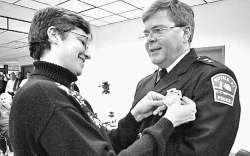 |
Gipson
Appoints Police Command Staff
By VANESSA THOMAS
News Staff Reporter
2/16/2006
Incoming Buffalo Police Commissioner H. McCarthy Gipson swore
in five chiefs and two deputy commissioners Wednesday
afternoon during a ceremony described as "a new day in
the history of the Police Department."
More than 120 family, friends and fellow officers crowded
Police Headquarters for the event. Gipson, a 35-year law
enforcement veteran who is expected to be confirmed next week,
appointed each member of his command staff on Wednesday.
The appointments included two detective sergeants - Daniel
Derenda as deputy commissioner of operations and Byron C.
Lockwood as first deputy commissioner of administration. |
Harry Scull Jr./Buffalo News
Dennis J. Richards gets his Chief badge from his wife,
Mary, during a swearing-in ceremony Wednesday |
|
Dennis J. Richards was named chief of
detectives. Others appointed as chiefs are: Jim Shea, South
District, who will also oversee the Traffic and Flex units;
Marcia Scott, Ferry-Fillmore District; Arturo Salas, Northwest
District; Donna Berry, Central District; and Anthony J. Barba,
Northeast District.
Berry missed the ceremony because of a vacation that was
"scheduled a long time ago," Gipson said.
"This is a new day in the history of the Buffalo Police
Department," Gipson said. "We're looking forward to
combating blight and crime. Please don't expect miracles
because I can't promise any, but we pledge to work our hardest
to serve the citizens of Buffalo and forge a
renaissance."
After the ceremony, Gipson and his new staff detailed plans to
improve the Police Department.
Gipson said one of his top priorities will be addressing
quality-of-life crimes such as loitering, prostitution and
littering, because "all these little things lead to
bigger crimes." He also said each police district will
launch "mini task forces" on days when manpower
permits, to target crimes plaguing district neighborhoods.
For the first time, two-officer cars will be used when there
is extra manpower, but there are no immediate plans to utilize
two-officer cars in high-crime areas, he said.
Derenda added that officers will receive new job-specific
training, including homicide and narcotics detectives.
"We want to make Buffalo safer for people to live, work
and raise their families," said Derenda.
|
|
|
|
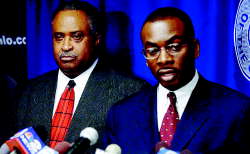 |
Gipson
Named City Police Commissioner
Spent 27 years in department,
then 7 with sheriff
By BRIAN MEYER and VANESSA THOMAS
News Staff Reporters 2/2/2006
When H. McCarthy Gipson became a Buffalo police officer 35
years ago, it was a different police department.
In 1971, Gipson made $7,226 a year. There were 1,400 people on
the police force in a department that spent about $19 million. |
|
| Thirty-five years later, Gipson has been
nominated by Mayor Byron W. Brown to become Buffalo's first
African-American police commissioner. He inherits a department
that has dramatically changed since his early law enforcement
days. The force has shrunk to 774 officers. Spending exceeds
$90 million with fringe benefits, making it the city's most
costly department.
Gipson, a city police officer for 17 years before rising
through the ranks, retired from the department as a captain in
1998 to accept a job in then-Erie County Sheriff Patrick M.
Gallivan's cabinet. Since his departure, the Buffalo force has
continued to shrink, the department has moved to one-officer
cars, and wages have been frozen by the control board.
Gipson, 57, known to friends as "Mac," said he will
focus on community policing and building police morale. He is
also considering boosting manpower in an understaffed
Narcotics Unit, increasing the responsibilities of district
detectives and reorganizing the specialty units. He is also
promising to be an "on the streets" commissioner who
will visit station houses "at all hours."
"I feel truly blessed to have the chance to go back and
lead the officers of the Buffalo Police Department,"
Gipson said Wednesday. "They have a very proud and strong
tradition of providing service to the citizens."
Gipson is widely respected in law enforcement circles and was
described as professional and hardworking.
When he was county holding center superintendent, Gipson was
criticized when a Scientology church member financed a 2001
trip for Gipson and a deputy superintendent to visit a Mexican
prison where they observed a Scientology anti-drug program.
On Wednesday, Gipson said he is a Christian and not a
Scientologist, but saw the value of the program because
"hard-core convicts appeared to be cured of drug
addiction."
Brown picked Gipson from a field of 50 candidates, including
18 applicants who were interviewed by the mayor's transition
team. Brown also appointed Daniel Derenda and Byron Lockwood
deputy police commissioners. Both are detective sergeants and
each has two decades of departmental experience.
While Gipson still must be confirmed by the Common Council,
which appears certain, he is already giving some early
glimpses of his concerns and priorities.
He believes the city might have to rethink plans that call for
a continued downsizing of the police to 675 officers. He said
there have been some "significant events" since the
downsizing plan was drafted three years ago, including the
possibility that a casino will be built downtown.
"I would actually like to have the opportunity to revisit
the level of manpower to be utilized in the Buffalo Police
Department in the next couple of years," he said.
Gipson also hopes to motivate officers to view themselves as
neighborhood service-providers. But he said effective law
enforcement requires a blend of skills.
"We're going to have to be mobile, agile and slightly
hostile in trying to get the job of policing done in the City
of Buffalo," he said.
Some community activists, rank-and-file officers and business
leaders praised Gipson's appointment.
When Officer Alphonso Wright joined the police force in 1988,
Gipson was his lieutenant at the old Precinct 8 at 647
Fillmore Ave.
"McCarthy is an excellent choice because he is fair,
honest, and always made sure that officers put their best foot
forward," said Wright. "He held people accountable
and was fair, as long as you did your job. He knows what's
happening in the streets because he was a street police
officer.
Several officers urged Gipson to implement two-officer police
cars in crime-ridden neighborhoods.
"Proactive policing is next to impossible to do when
you're out there by yourself," said Ferry-Fillmore
Officer Greg O'Shei, who works nights in one of most violent
districts in the city. "It's hard when you're by yourself
to approach a big group gathered on the corner. The officers
are really at a disadvantage."
Police union president Robert P. Meegan Jr. said he has known
Gipson for decades and feels he "possesses the good
leadership and good direction" for the department. He
also supports Gipson's plans to consider using two-officer
police cars in high-crime neighborhoods.
"The former police commissioner [Rocco J. Diina] was more
hell-bent on monetary issues versus protecting officers and
the safety of citizens," said Meegan. "I'm happy to
hear McCarthy's statements today that he is concerned about
the reduction of manpower."
Jonathan A. Dandes, who chairs the Government Affairs
Committee of the Buffalo Niagara Partnership, the area's
largest business group, thinks Gipson's knowledge of the
Buffalo Police Department and the county Sheriff's Department
will foster more collaboration between law enforcement
agencies.
The head of a city panel created to improve race relations and
probe claims of police misconduct also praised the
appointment. Rita Hubbard-Robinson, executive director of the
Commission on Citizens' Rights, hopes Gipson will resolve a
three-year battle involving the panel's push for access to
closed case files on internal probes into police misconduct.
The two sides have been unable to agree on disclosure
procedures.
Brown named five people to chief-level positions Wednesday.
Northwest District Capt. Dennis J. Richards was named chief of
detectives. The other chiefs are Donna Berry, Arturo Salas,
Marsha Scott and James Shea.
The responsibilities of the chiefs and deputy commissioners
have been reorganized. Now, one chief is chief of detectives,
while the other five chiefs will be in charge of each of the
five police districts. The two deputy commissioners will have
added responsibilities, heading up fiscal operations and
administration. Brown must appoint one more chief. |
|
|
|
|
|
|
|
